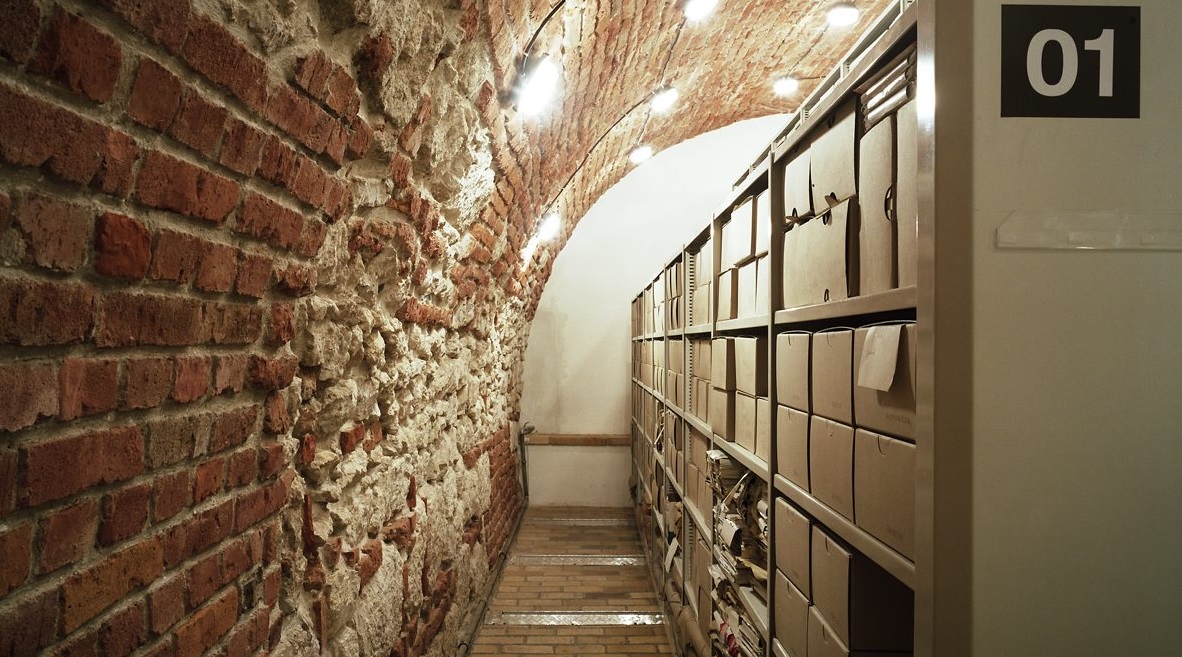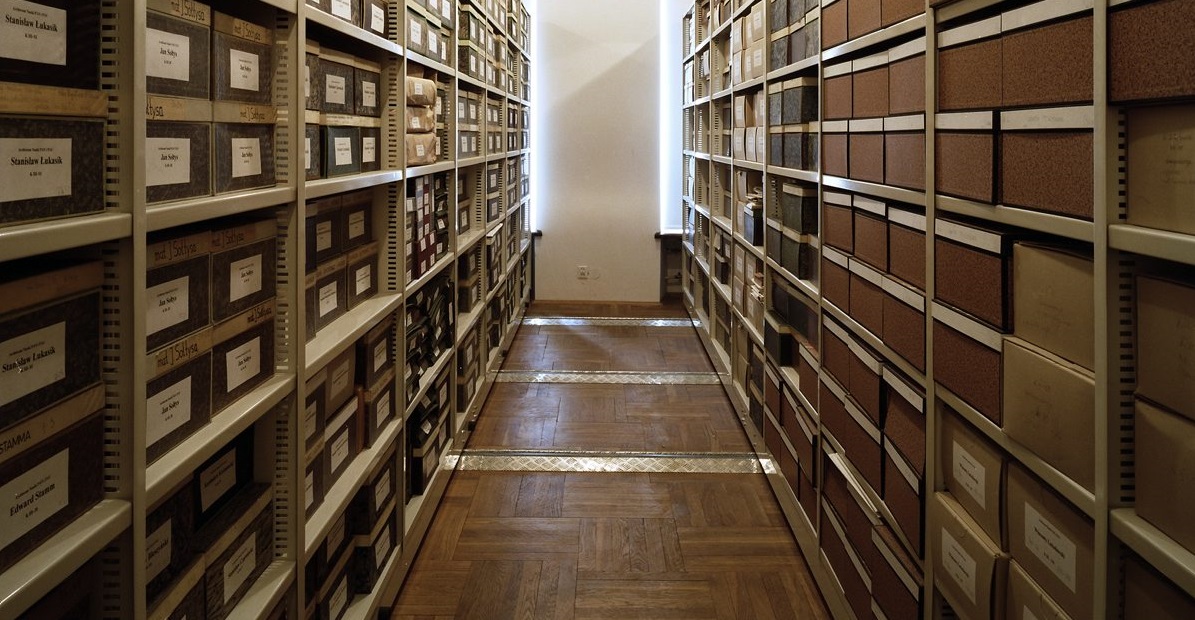Library collection
The Library of the Archive of Science includes over 17 thousand volumes, and functions as a repository of research tools for scholars and the Archive employees. It mostly contains publications on history of science, culture, education, literature, history of Poland, biographical writings, archival studies, source publications, as well as dictionaries, encyclopedias, guides, catalogues and trade periodicals. It is composed of three parts which complement one another. The first one, the most extensive, regularly supplemented, collects publications on the above mentioned themes, in accordance with the Archive’s profile. The other two are: the Lanckoroński Rozdół (Rozdil) Library donated by Prof. Karolina Lanckorońska and the purchased book collection of Prof. Henryk Barycz.
The library resources may be accessed in the Archive’s Reading Room.
Henryk Barycz (1901–1994) was a professor of the Jagiellonian University, historian of science, education and culture, member of the Polish Academy of Arts and Sciences (who helped to re-establish it in 1989), archivist and long-time head of the Archive of the Jagiellonian University. As he recalled himself, he started collecting books already as a secondary school student. Later he purchased books in bookshops and antiquarian shops, received them as gifts from friends, publishing houses, universities, organizations, at conferences and conventions, which a lot of dedications in the books confirm.
Henryk Barycz’s library constitutes a rich collection of research tools on the history of science and culture. It contains around 6,000 volumes from the 19th and 20th centuries. It includes titles from the fields of general history, history of Poland, history of science, culture and art, memoirs, belles-lettres, biographies, monographs of cities and regions, and primary documents. It has basic bibliographies of Polish literature, catalogues of manuscripts, archival inventories, sources and literature concerned with the history of the Jagiellonian University and a collection of publications for research on the history of the Reformation in Poland, the history of Silesia and Galicia; moreover, annual volumes of “Kwartalnik Historyczny”, “Nauka Polska”, “Przegląd Historyczno-Oświatowy”, complete sets of the periodicals “Reformacja w Polsce” and “Odrodzenie i Reformacja w Polsce”.
What deserves special emphasis is the unique collection of over 4,000 copies of Polish and foreign publications in the above mentioned fields. The books are provided with bookplates and often include the Professor’s notes, a proof of his thorough reading. A lot of books come with dedications by Polish and foreign scholars, which confirms Henryk Barycz’s extended academic connections as well as his authority. In 1994 the book collection was bought by the Polish Academy of Arts and Sciences for the Archive of Polish Science established on the strength of a resolution of the general assembly of the PAU on 25 June 1994 (at present this role is performed by the Archive of Science of the PAN and the PAU.
The Lanckoroński Rozdół Library
Karolina Lanckorońska (1898–200) was the last member of the Lanckoroński family of Brzezie, art historian, professor of Polish University Abroad in London, long-time collaborator and from 1990 member of the PAU; in 1997 she donated to the Academy a rescued part of her family Rozdół Library. The founder of the library was Ludwika Lanckorońska née Rzewuska (1783–1839), a cultivated lady with broad intellectual interests. As a wife of Antoni Lanckoroński (1760–1830), part of her dowry was the estate in Rozdół, where the palace held a book collection which went far beyond typical manor libraries of the time.
Separate departments held encyclopedias, historical, travel, geographical, philosophical and political books, journals, dictionaries, biographies, novels, books in Italian, German, French, English and Latin.
After the death of Ludwika Lanckorońska, her son Kazimierz Lanckoroński (1802–1874) took over the supervision of the book collection, supplementing it, yet only within the existing sections. It was the next successor, Karol Lanckoroński (1848–1933) that significantly increased the range of books, both in terms of quantity and themes. As a scholar, art collector, patron of the arts, he transformed the family book collection into a professionally organized library, run by librarian Ludwik Chotyniecki, comprising in the early 20th century around nineteen thousand volumes.
The 1914 warfare in Galicia did not spare Rozdół, bringing on pillage and destruction. In 1915, taking advantage of the Austrian troops’ successes on the eastern front, Karol Lanckoroński took the surviving furnishings of the palace, the photograph collection (the Photothèque) and the library to Vienna, where they were stored until the 1940s.
During the Second World War the Lanckoroński property was requisitioned by the Nazis; the art collection and the library got dispersed and partly destroyed. After 1945, Karol’s son, Antoni Lanckoroński (1893–1965) made efforts to regain the family property in Austria, including the rescued works of art and books. On 6 December 1968 the recovered book collection was deposited at the Polish Library in London, where it was inventoried and rearranged.
Karolina Lanckorońska decided to make it a sort of a repository of research tools on Polish history Consequently, the library contains 2,960 inventory numbers. In August 1996 Professor Lanckorońska decided to bequeath it to the PAU. The collection was taken to the Archive building at 26, św. Jana Street in August 1997, where, along with a personal archive, it constitutes Karolina Lanckorońska’s legacy.
Theme-wise, the range of the book collection goes way beyond the profile of the Archive library. It comprises over 3,000 volumes, of which 800 are antique books. It is hardly possible to describe here the whole collection but it is worth mentioning e.g. the unique collection of manually annotated Old Polish calendars of 1693–1770, political pamphlets of the 17th and 18th centuries, Volumina Legum, 18th-century editions of medieval literary works and modern-time chronicles, as well as a set of “Zabawy Przyjemne i Pożyteczne” (Diversions Pleasurable and Useful), an 18th-century weekly.
Among the 19th- and 20th-century publications Polish belles-lettres prevail, particularly from the Romantic period (including a lot of editions of works by Adam Mickiewicz and Juliusz Słowacki), publications on history of art, geography, military science, history of Poland, memoirs, armorials by Bartosz Paprocki, Kasper Niesiecki, Stanisław Józef Duńczewski, as well as atlases, travel guides, fairy tales and albums.



